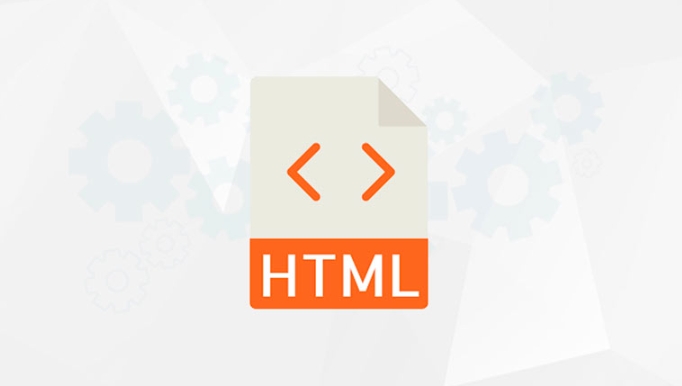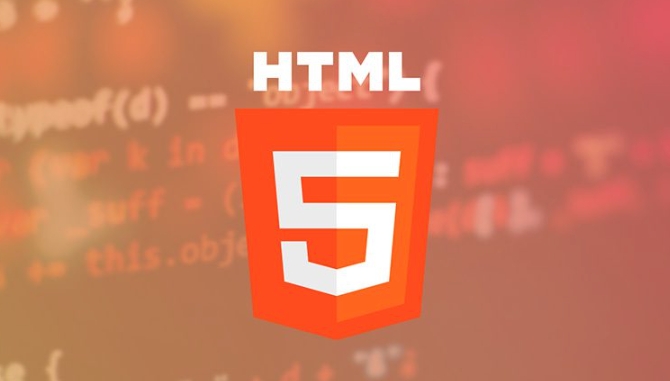Leveraging Custom Data Attributes in HTML5 for Storing Information
Jul 11, 2025 am 02:03 AMThe data-* attribute is a feature in HTML5 used to store custom data, allowing information on elements that does not affect the structure and style of the page. 1. It is defined by data-followed by custom names, such as
; 2. Advantages include strong readability, avoiding naming conflicts, and good compatibility; 3. Data can be obtained or set through JavaScript dataset objects, such as element.dataset.userId; 4. It is often used to store AJAX parameters, control component status, and pass plug-in configuration; 5. When using it, you need to pay attention to not having sensitive information, avoiding a large amount of data, reasonably naming, and keeping updates and synchronous.
Sometimes we need to store some extra information on the HTML element, but we don't want to affect the structure or style of the page. At this time, the custom data attributes (data-*) provided by HTML5 come in handy.

What is the data-* attribute?
data-* is a standard way introduced in HTML5, allowing us to store arbitrary custom data on elements. Its naming format is data- followed by a name you define yourself, such as:

<div data-user-id="123" data-role="admin"></div>
These properties are not rendered into visual content by the browser, nor affect the page layout, but can be easily accessed and operated through JavaScript. Ideal for saving some meta information related to DOM elements.
Why use the data-* attribute?
Compared with common practices in the past, such as writing information in class or id, or storing it through hidden input, data-* is more semantic, standardized, and easier to maintain.

It has several obvious advantages:
- Strong readability : Others can see which custom data are at a glance when looking at your HTML.
- Avoid naming conflicts : data-* The name is controlled by you and will not collide with other attributes.
- Good compatibility : modern browsers support it, and libraries such as jQuery also have built-in convenient APIs to read and write them.
How to use it in practice?
Using data-* in a project is generally used in combination with JavaScript. For example:
Get data
const element = document.querySelector('#myElement'); const userId = element.dataset.userId; // Pay attention to the camel naming
If you write data-user-id in HTML, the corresponding dataset.userId in JavaScript is dataset.userId .
Setting up data
element.dataset.prefetchUrl = '/api/user/123';
This automatically creates data-prefetch-url property on the element.
Common application scenarios include:
- Store parameters required for AJAX request
- Control component status (such as whether the menu is expanded)
- Pass configuration items to front-end plug-in
For example, you have a button that needs to load user data after clicking, you can write it like this:
<button data-user-id="456" class="load-user">Load user</button>
Then listen to the click event in JS, and directly take the value from dataset.userId to request the interface.
What should you pay attention to when using it?
Although data-* is very convenient, it is not used casually. There are a few details to note:
- Don't store sensitive information : because this data is exposed to HTML and anyone can see it.
- Avoid large amounts of data : Although you can store JSON strings in, don't use them as a client database.
- Reasonable naming : The name should be meaningful, try to unify the style as much as possible, and facilitate teamwork.
- Pay attention to update synchronization : If the data changes frequently, remember to update the corresponding data-* value, otherwise you may get old data.
If you need to use multiple words, it is recommended to separate them with hyphen, which will become camel-like access in JS. For example, data-item-index → dataset.itemIndex .
Basically that's it. The data-* attribute is a small and practical function. The rational use can make the front-end code clearer and more organized.
The above is the detailed content of Leveraging Custom Data Attributes in HTML5 for Storing Information. For more information, please follow other related articles on the PHP Chinese website!

Hot AI Tools

Undress AI Tool
Undress images for free

Undresser.AI Undress
AI-powered app for creating realistic nude photos

AI Clothes Remover
Online AI tool for removing clothes from photos.

Clothoff.io
AI clothes remover

Video Face Swap
Swap faces in any video effortlessly with our completely free AI face swap tool!

Hot Article

Hot Tools

Notepad++7.3.1
Easy-to-use and free code editor

SublimeText3 Chinese version
Chinese version, very easy to use

Zend Studio 13.0.1
Powerful PHP integrated development environment

Dreamweaver CS6
Visual web development tools

SublimeText3 Mac version
God-level code editing software (SublimeText3)
 Handling reconnections and errors with HTML5 Server-Sent Events.
Jul 03, 2025 am 02:28 AM
Handling reconnections and errors with HTML5 Server-Sent Events.
Jul 03, 2025 am 02:28 AM
When using HTML5SSE, the methods to deal with reconnection and errors include: 1. Understand the default reconnection mechanism. EventSource retrys 3 seconds after the connection is interrupted by default. You can customize the interval through the retry field; 2. Listen to the error event to deal with connection failure or parsing errors, distinguish error types and execute corresponding logic, such as network problems relying on automatic reconnection, server errors manually delay reconnection, and authentication failure refresh token; 3. Actively control the reconnection logic, such as manually closing and rebuilding the connection, setting the maximum number of retry times, combining navigator.onLine to judge network status to optimize the retry strategy. These measures can improve application stability and user experience.
 Integrating CSS and JavaScript effectively with HTML5 structure.
Jul 12, 2025 am 03:01 AM
Integrating CSS and JavaScript effectively with HTML5 structure.
Jul 12, 2025 am 03:01 AM
HTML5, CSS and JavaScript should be efficiently combined with semantic tags, reasonable loading order and decoupling design. 1. Use HTML5 semantic tags, such as improving structural clarity and maintainability, which is conducive to SEO and barrier-free access; 2. CSS should be placed in, use external files and split by module to avoid inline styles and delayed loading problems; 3. JavaScript is recommended to be introduced in front, and use defer or async to load asynchronously to avoid blocking rendering; 4. Reduce strong dependence between the three, drive behavior through data-* attributes and class name control status, and improve collaboration efficiency through unified naming specifications. These methods can effectively optimize page performance and collaborate with teams.
 Receiving real-time data with HTML5 Server-Sent Events (SSE).
Jul 02, 2025 pm 04:46 PM
Receiving real-time data with HTML5 Server-Sent Events (SSE).
Jul 02, 2025 pm 04:46 PM
Server-SentEvents (SSE) is a lightweight solution provided by HTML5 to push real-time updates to the browser. It realizes one-way communication through long HTTP connections, which is suitable for stock market, notifications and other scenarios. Create EventSource instance and listen for messages when using: consteventSource=newEventSource('/stream'); eventSource.onmessage=function(event){console.log('Received message:',event.data);}; The server needs to set Content-Type to text/event
 Declaring the correct HTML5 doctype for modern pages.
Jul 03, 2025 am 02:35 AM
Declaring the correct HTML5 doctype for modern pages.
Jul 03, 2025 am 02:35 AM
Doctype is a statement that tells the browser which HTML standard to use to parse the page. Modern web pages only need to be written at the beginning of the HTML file. Its function is to ensure that the browser renders the page in standard mode rather than weird mode, and must be located on the first line, with no spaces or comments in front of it; there is only one correct way to write it, and it is not recommended to use old versions or other variants; other such as charset, viewport, etc. should be placed in part.
 Improving SEO with HTML5 semantic markup and Microdata.
Jul 03, 2025 am 01:16 AM
Improving SEO with HTML5 semantic markup and Microdata.
Jul 03, 2025 am 01:16 AM
Using HTML5 semantic tags and Microdata can improve SEO because it helps search engines better understand page structure and content meaning. 1. Use HTML5 semantic tags such as,,,, and to clarify the function of page blocks, which helps search engines establish a more accurate page model; 2. Add Microdata structured data to mark specific content, such as article author, release date, product price, etc., so that search engines can identify information types and use them for display of rich media summary; 3. Pay attention to the correct use of tags to avoid confusion, avoid duplicate tags, test the effectiveness of structured data, regularly update to adapt to changes in schema.org, and combine with other SEO means to optimize for long-term.
 Explaining the HTML5 `` vs `` elements.
Jul 12, 2025 am 03:09 AM
Explaining the HTML5 `` vs `` elements.
Jul 12, 2025 am 03:09 AM
It is a block-level element, suitable for layout; it is an inline element, suitable for wrapping text content. 1. Exclusively occupy a line, width, height and margins can be set, which are often used in structural layout; 2. No line breaks, the size is determined by the content, and is suitable for local text styles or dynamic operations; 3. When choosing, it should be judged based on whether the content needs independent space; 4. It cannot be nested and is not suitable for layout; 5. Priority is given to the use of semantic labels to improve structural clarity and accessibility.
 Getting the user's current location with the HTML5 Geolocation API.
Jul 02, 2025 pm 05:03 PM
Getting the user's current location with the HTML5 Geolocation API.
Jul 02, 2025 pm 05:03 PM
When using HTML5Geolocation API to obtain user location, you must first obtain user authorization, and request and explain the purpose at the right time; the basic method is navigator.geolocation.getCurrentPosition(), which contains successful callbacks, wrong callbacks and configuration parameters; common reasons for failure include permission denied, browser not supported, network problems, etc., alternative solutions and clear prompts should be provided. The specific suggestions are as follows: 1. Request permissions when the user operation is triggered, such as clicking the button; 2. Use enableHighAccuracy, timeout, maximumAge and other parameters to optimize the positioning effect; 3. Error handling should distinguish between different errors
 Understanding HTML5 Media Source Extensions (MSE)
Jul 08, 2025 am 02:31 AM
Understanding HTML5 Media Source Extensions (MSE)
Jul 08, 2025 am 02:31 AM
MSE (MediaSourceExtensions) is part of the W3C standard, allowing JavaScript to dynamically build media streams, thus enabling advanced video playback capabilities. It manages media sources through MediaSource, stores data from SourceBuffer, and represents the buffering time range through TimeRanges, allowing the browser to dynamically load and decode video clips. The process of using MSE includes: ① Create a MediaSource instance; ② Bind it to an element; ③ Add SourceBuffer to receive data in a specific format; ④ Get segmented data through fetch() and append it to the buffer. Common precautions include: ① Format compatibility issues; ② Time stamp pair






